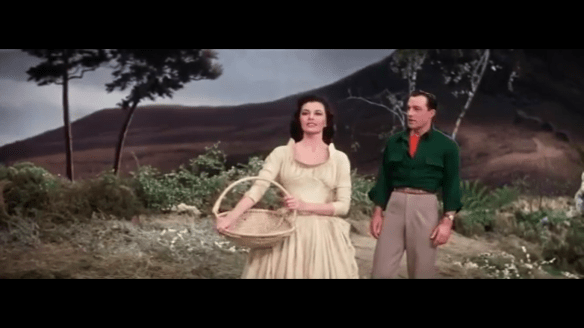I have fond memories of traipsing across the Old Course in St. Andrews and attending the Military Tattoo near the Royal Mile in Edinburgh. There’s something untamed about that landscape remaining austere and beautiful, perfectly suited for tartans, bellowing bagpipes, and the rat-ta-tat of drums. The country feels wild and free and still imbued with years of ancient history.
Brigadoon is hardly an authentic look at highland life. It was based on a Broadway play after all. They traded out the actual highlands for a studio backlot to save money. But as such, the world feels like a total Hollywood confection from Vincente Minnelli. I hardly mind just as I barely mind the California heather of National Velvet for a stand-in.
It comes down to representing a place that is more mythic than a concrete place we know firsthand. It exists in our memories and recollections. Now, this is dangerous: It can lead to a myriad of stereotypes and misconstrued truths. I’m not sure how cultural appropriation or even “whitewashing” ties into this tale, but it’s true Hollywood has borrowed from the Scotts and spun their own version.
However, the film itself couldn’t be more pleasant. Gene Kelly and Van Johnson are lost up in the fogs of the highland in the midst of their pheasant hunting expedition. Meanwhile, we get acclimated to the village of Brigadoon. There’s a charming number, “Waiting for My Dearie,” with Cyd Charisse surrounded by all the fair maidens of the town as she dances with a gal with a pot for a helmet and a mustache on her lip. They all prepare for the marriage of Fiona’s sister to a local lad.
Johnson and Kelly are soon integrated into the community through a moment of gaiety as the tune “Bonnie Jean” becomes emblematic of the merry way of life these people live where song and dance are the only conceivable way to express themselves. In this way, it seems to suit the parameters that the musical inherently provides.
However, something else happens: Tommy (Kelly) falls for Fiona (Charisse) almost at first site. What else would you expect because every character he ever played must fall hopelessly in love with the girl. This is what Fred Astaire did a generation before them.
He’s pleased to find it is the younger Campbell lass who is getting married and not the elder. “The Heather on The Hill” feels like the lynchpin number. We saw something similar in “Dancing in The Dark” with Astaire playing opposite Charisse in The Band Wagon. Because this is the moment where all other distractions momentarily subside, and we are able to distill this movie down to its core relationship. What other emotion could dance hope to convey but the rapturous, ineffable palpations of romantic joy.
It’s enchanting to watch their forms move so fluidly through the space where they become an extension of the world around them. Where a limb of a tree or a basket is part of their movements and the dance that they are undertaking together. It says all the things they feel for one another not in word but in deed and action, and it feels all the more evocative for this very reason.
It occurs to me that dance often comes in two distinct forms: there’s the utterly communal and then the strikingly intimate. They bring people together, reflect their woes, and put a voice to their romantic elation. Sometimes they’re even comic. Johnson more than provides his share of sardonic wisecracks, and he’s quite good in the role.
However, my main qualm with the picture is in the story department. Now the film is based on a stage production, and that’s where the initial weakness lies. Because this is yet another tale of transcendent love. We learn something telling about Brigadoon midway through the movie, which would have been helpful for setting the stakes early on.
It’s hardly an “I See Dead People” revelation, but it tries to give some context to why these folks live so isolated from mankind — all but forgotten — and so Fiona takes them to the village schoolmaster to tell the tale. Salient or not, the movie slows down to explain itself and thus loses some of its luster in the process. They don’t even try and use song and dance to save it from the horrors of over-exposition.
Likewise, the ending feels all crammed together and while we have the tent pole moments one might expect from a Golden-era MGM musical, the narrative cohesion simply is not simpatico. The two travelers leave Brigadoon behind for the urban hysteria back in New York. The juxtaposition is obvious and Tommy’s having none of it; he vows to return to the one place he’s ever truly been happy.
It’s dubious that a wise guide in one moment can explain the mysterious nature of Brigadoon, and then still later can announce with a grin how grand romance can supersede all manner of hindrances between two lovers. It’s like the most convenient cop-out explanation — the path of least resistance.
There’s the expected reunion. It’s what the story is meant to build up to — there’s this sense of appreciation, after all, Gene and Cyd are back together as they should be. But something else nags at us. It feels hollow because the story doesn’t gel — it doesn’t feel earned — and we wanted this reunification more than anything. It’s a shame because otherwise I’m a big fan of what Brigadoon represents and no matter its flaws, it still remains an underrated musical.
I’m not surprised Charisse voiced it as her favorite picture with Gene Kelly. Their scene together in Singin in Rain is a provocative showstopper, and It’s Always Fair Weather blooms with a melancholy and timeliness in the television age. In Brigadoon, you could easily argue they share some of their finest individual moments together regardless of your verdict of the overall film.
3.5/5 Stars


